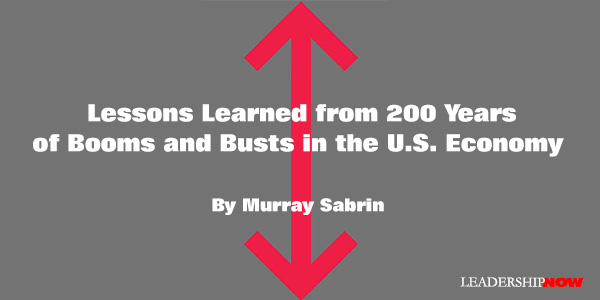 |
 |
11.17.21

Lessons Learned from 200 Years of Booms and Busts in the U.S. Economy
THE business cycle in the United States has been characterized by an ongoing series of economic booms and busts, bubbles and bursts, despite efforts by the Federal Reserve to stabilize the ups and downs. The first recognizable boom and bust cycle in the U.S. economy occurred after the War of 1812 when inflated prices created an unstainable boom. Expansionist activities of farmers, exporters, and, particularly, investment bankers — spearheaded by the Second Bank of United States — sowed the seeds of the boom leading to the bust. Supply of money declined, and liquidity became a problem for many sectors, and the Panic of 1819 soon followed with all the characteristics of future business cycles in the 19th century. Boom-bust cycles, for many decades, were called “panics.” Thirteen financial panics occurred from 1792 to 1896, and the last official panic occurred in 1907. After that, panics were renamed — first to depression and then to the milder sounding term, recession. Following the recovery from the Panic of 1907, President Woodrow Wilson signed the Federal Reserve Act into law in 1913. The Federal Reserve was charged with preventing financial panics and stabilizing the economy. America’s bankers, who spearheaded the effort, finally got a central bank whose mission was to be a lender of last resort, smooth out the business cycle, and maintain the purchasing power of the dollar. Congress expanded the Federal Reserve’s responsibilities in 1946, directing it to promote maximum employment, production, and purchasing power. And in 1978, Congress added price stability and promotion of long-term growth to its mandate. Yet, as history proves, the business cycle hasn’t been “smoothed out.” The U.S. has subsequently been rocked by the Great Depression, followed by several recessions. The reoccurring phenomenon of money creation, speculation, boom, malinvestments, crisis, and depression hasn’t ended, but rather, the Federal Reserve destabilizes the economy by manipulating short-term interest rates. The federal government primes the pump with deficit spending, and the Federal Reserve opens the money spigot to give the economy additional oomph to boost the economy. The inevitable bust arrives when the Federal Reserve raises interests rates and withdraws liquidity from the financial system to dampen the overheated economy. More recently, the dot-com bubble of the late 1990s and the housing bubble of the mid-2000s reaffirm the consequences of the Federal Reserve’s easy money infusions. We’re now in what some analysts call the “everything bubble,” which was well underway before the pandemic struck in 2020. If history is any guide, it could last until the end of the 2020s. The boom-bust cycle, therefore, isn’t inherent in the market economy but instead is a consequence of the Federal Reserve intervening in the short-term money markets ostensibly to stabilize the economy and promote economic growth and full employment. To ride out the peaks and troughs of the boom-bust cycles, businesses must understand and adjust their behavior to the cycle. Here are ways to identify that the economy’s boom cycle is about to end:
The U.S. economy has become dependent on more and more debt — and financial boosts — to generate economic growth. But as history shows, when it comes to the business cycle, what goes up must come down.  
Posted by Michael McKinney at 01:48 PM
|
BUILD YOUR KNOWLEDGE
 

How to Do Your Start-Up Right STRAIGHT TALK FOR START-UPS 
Grow Your Leadership Skills NEW AND UPCOMING LEADERSHIP BOOKS 
Leadership Minute BITE-SIZE CONCEPTS YOU CAN CHEW ON 
Classic Leadership Books BOOKS TO READ BEFORE YOU LEAD |